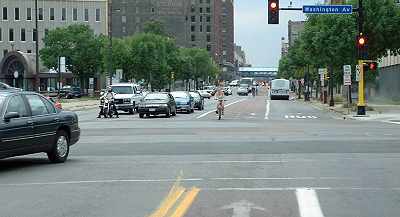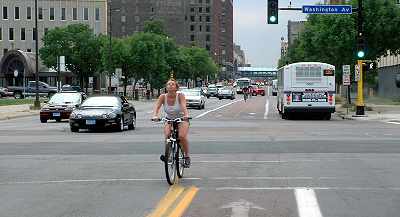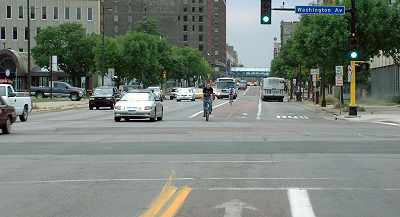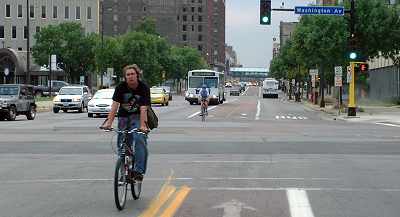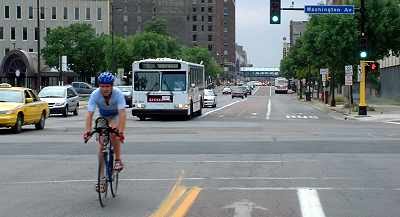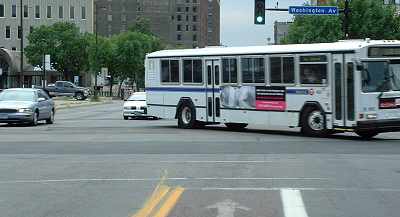Bike and bus
John S. Allen
Bicyclists and buses can coexist well as long as the bus drivers act professionally and
the bicyclists operate in the vehicular manner. Each must overtake the other with about
1.5 meters (5 feet) of lateral clearance, and avoiding getting on the wrong side of the
other. The two unposed photos below were taken from the stoker's seat of a tandem bicycle,
during a ride on an arterial street. |
Bicyclist properly overtaking stopped bus, far enough from
the side of the bus to see
and avoid passengers crossing in front of the bus, and where the bus driver will
look for overtaking traffic. If the bus driver nonetheless begins to merge left,
the bicyclist has room to escape by braking and dropping back .

Bus properly overtaking bicyclist. Location for both photos:
Massachusetts Avenue, Arlington, Massachusetts, USA
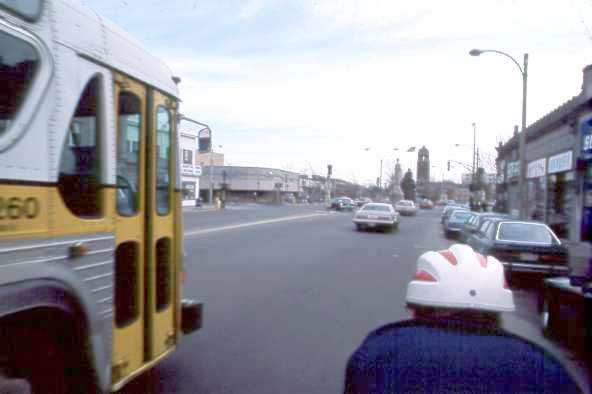
Common errors
Common errors of bus drivers are
overtaking with too little clearance, leaving the bicyclist too little
room to avoid obstacles without the risk of colliding with the side of the bus.
turning or merging (toward the bicyclist) before having finished
overtaking.
merging into the path of a bicyclist when pulling out from a bus stop.
not pulling close to the curb at a bus stop, thereby encouraging
bicyclists to overtake between the bus and the curb and in the path of passengers
alighting from or getting onto the bus.
Common errors by bicyclists around buses are
Any of these mistakes can be deadly. The bus is long enough to sweep
across the bicyclist when turning. If the bus is going faster than the bicyclist, and the
bicyclist's handlebar end strikes it, the bicyclist will fall toward the bus. Devices do
exist to keep bicyclists and pedestrians from falling under the rear wheels of buses, but
these devices are not in common use.
A bicyclist who operates as recommended here requires no unusual attention
from the bus driver, but in addition, bicyclists can prevent bus drivers from making
mistakes by means of lane positioning and hand signals. Bus drivers' only defense with
bicyclists who do not position themselves to be visible, and who violate the rules of the
road, is to be cautious and vigilant.
Infrastructure to accommodate buses and bicyclists
Turnouts at bus stops (that is, widening the street at bus stops, or
placing the bus stops in the same line with on-street parking) improve traffic flow for
bicyclists, and for all other vehicle operators except possibly, the bus drivers, who must
merge back into the traffic flow when leaving the bus stop.
If the bus does not turn left, a bike lane to
the left of a bus lane requires more road width, but does not violate the basic principles
of traffic flow. If the next lane to the left of the bike lane carries traffic in the same
direction, the bus lane is also used by all other vehicles merging to turn. However, if
the next lane carries traffic in the opposite direction, bicyclists have little
opportunity to avoid turning motorists who fail to yield. The next two photos illustrate
these different situations.
|
Bike lane on street side of bus lane (University
Ave., Madison, Wisconsin, USA.)
Buses, on their fixed route, do not turn left across the bike lane.
The bus lane also serves as a right-turn lane; the lane to the
left of the bike lane carries traffic in the same direction.
(wider overhead view and
discussion of University Avenue)
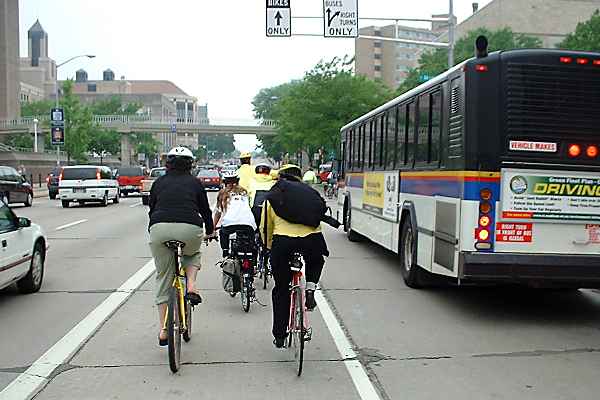
Below: bus lane, then bike lane, then lane carrying
traffic in the opposite direction,
increasing hazard of head-on collisions with turning vehicles. Also, buses
turn left from the bus lane (Marquette Avenue, Minneapolis, Minnesota, USA).
(More photos, and
discussion of Marquette Avenue)
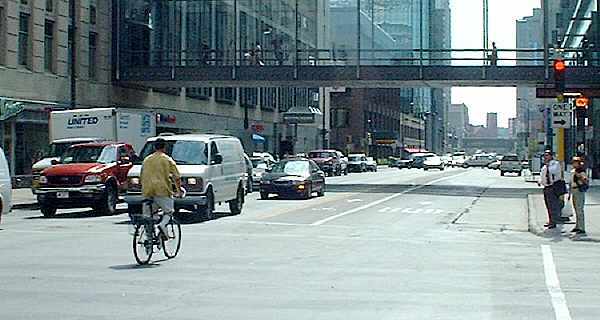
-
A lane restricted to buses, bicycles and vehicles
preparing to turn right, without a barrier between it and the rest of the street, requires
bicyclists and bus drivers to "leapfrog" one another but in my experience,
functions better than a conventional, narrow bike lane: motorists uniformly merge into the
bus/bike lane before turning right. The relatively light bus traffic, and the professional training of the bus
drivers compensate for the awkwardness of bicyclists' sharing a lane with buses. The buses
can merge partway into the next lane to overtake the bicyclists.
|
Bus/bike lane, Chestnut Street, Philadelphia,
Pennsylvania, USA.
The lane is also legally open to right-turning traffic, though
the sign does not indicate this, and the cars in the background
are going straight through -- compliance with the lane
restriction is spotty here.
By not mentioning
the specific exemption,
the sign promotes
disrespect for the law.

Shared bus/bike lanes in Germany
 The following material (inside the border) is a translation of a page in German on the Web site of
the Allgemeiner Deutscher Fahrrad-Club (German Cycling Federation ADFC). The German
treatment uses shared lanes like those in Philadelphia. Technical information on this
treatment is available, on an additional Web page (now in
English) from the ADFC Web site The following material (inside the border) is a translation of a page in German on the Web site of
the Allgemeiner Deutscher Fahrrad-Club (German Cycling Federation ADFC). The German
treatment uses shared lanes like those in Philadelphia. Technical information on this
treatment is available, on an additional Web page (now in
English) from the ADFC Web site
More rights for cyclists
Buses and bicyclists as a team
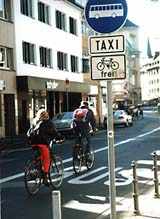 |
Despite all of the advertisements for faster bus travel showing smiling bus drivers,
buses get stuck in traffic jams at peak travel times. Only after bus lanes are installed
do the speeds increase in some segments -- but often to the disadvantage of bicyclists.
Usually, there is no place for bike lanes where bus lanes are provided. The solution can
be to open the bus lane to bicycle traffic as well, using the supplementary plaque
"Fahrrad frei" (open to bicyclists). |
If you take a couple of tips to heart, you can take good advantage of
this development. Bicyclists must ride as far right as possible, in order not to delay the
buses. Overtake carefully at bus stops, paying special attention to motor traffic and
crossing pedestrians. |
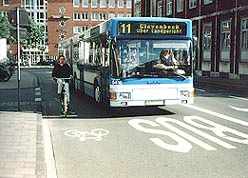 |
|
Bus route with conventional bike lane
- In the photo below, there is a conventional, narrow (approximately 1.5 meter wide) bike
lane in the street. The location is unusually favorable for a bike lane in that there are
no side streets, and so there is no cross traffic. A bus is properly stopped at the curb.
Stopping outside the bike lane would encourage bicyclists to ride between the bus and the
sidewalk, in conflict with passengers getting on and off the bus. However, passengers
still risk collision with bicyclists on the sidewalk, like the one in the photo.
|
Bus properly pulled to the curb at a bus stop (left
background of photo)
despite designated bike lane.
More about this installation including a discussion of
why the bicyclist is on the sidewalk here despite bike lanes:
"you can lead a horse to water."
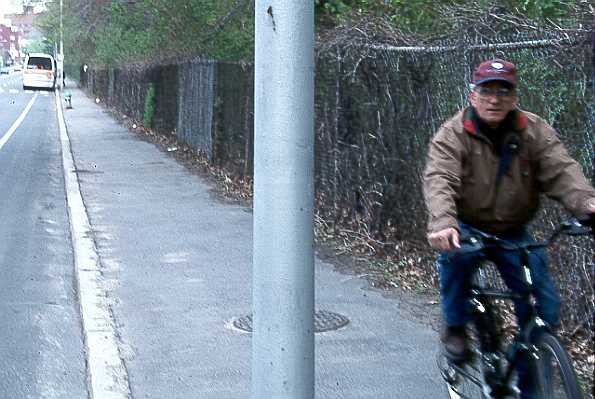
A typical designated bike lane adjacent to parallel parking poses the
risk of bicyclists' striking the opening doors of parked cars unless riding at the very
left edge of the lane. But the bus would be too close if the bicyclist were at the left
edge of the bike lane. In order to minimize risk, either the bus driver, or the bicyclist,
or both, must disregard the lane markings to allow more clearance when overtaking.
|
A conventional bike lane does not provide sufficient room
for
cyclists to avoid car doors while buses (and other vehicles)
in the adjacent lane maintain a safe distance.
[11th Street
S., Minneapolis, Minnesota, USA-- more photos, and discussion]
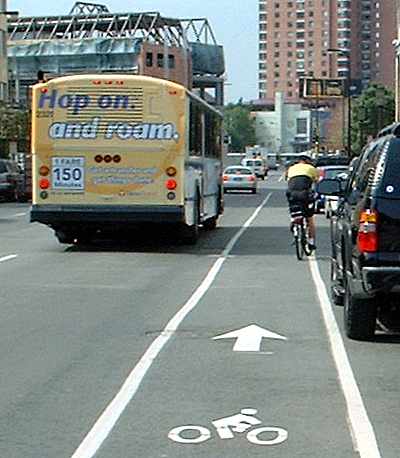
Other treatments
A combined bus/bike lane behind a barrier leads
to conflicts between turning and through traffic unless the conflicting movements are
prohibited, or are allowed only on a special signal phase. 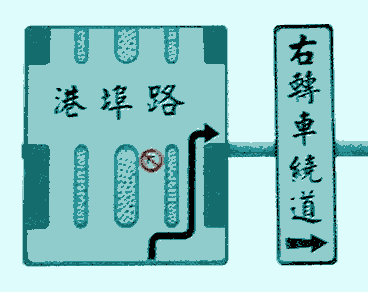 Taichung Harbor Road in Taichung, Taiwan shows examples of both
solutions. This major arterial has a divided center roadway, separated by a raised median
from a frontage road on either side, and with at-grade intersections. City buses, motor
scooters and bicycles are restricted to the frontage roads. Turning conflicts are
minimized by requiring motorists to merge from the center roadway to the frontage road one
block or more before turning, as indicated by a sign (right). At some intersections,
bicycles and motor scooters turn left from the frontage roads on a left-turn-only signal
phase also used by vehicles in the inner roadway. This increases delay, but it does allow
use of the pre-existing infrastructure without creating conflicts, and allows the center
roadway to be used for higher-speed traffic. Note in the photo below that there is a
"bike box" for motor scooters -- though there is no special lane for them other
than the frontage road itself, and the driver of a passenger car has encroached into the
"bike box." There is a general discussion of bike
boxes on another Web page. Taichung Harbor Road in Taichung, Taiwan shows examples of both
solutions. This major arterial has a divided center roadway, separated by a raised median
from a frontage road on either side, and with at-grade intersections. City buses, motor
scooters and bicycles are restricted to the frontage roads. Turning conflicts are
minimized by requiring motorists to merge from the center roadway to the frontage road one
block or more before turning, as indicated by a sign (right). At some intersections,
bicycles and motor scooters turn left from the frontage roads on a left-turn-only signal
phase also used by vehicles in the inner roadway. This increases delay, but it does allow
use of the pre-existing infrastructure without creating conflicts, and allows the center
roadway to be used for higher-speed traffic. Note in the photo below that there is a
"bike box" for motor scooters -- though there is no special lane for them other
than the frontage road itself, and the driver of a passenger car has encroached into the
"bike box." There is a general discussion of bike
boxes on another Web page.
|
Motor scooter operators sharing the outer roadway with city
buses and
general right-turning traffic, waiting for a traffic signal:
Taichung Harbor Road,Taichung, Taiwan.

At other intersections on Taichung Harbor Road,
motor scooter and bicycle operators are required to make two-point left turns from a
designated area at the far right corner of the intersection. Whether this results in more
or less delay than a normal, vehicular left turn depends on how congested the
traffic is, and whether motor scooters can filter forward on the right. The tradeoff is
between time required to merge across several lanes of traffic and the time waiting for
the light to change.
|
Designated waiting location for two-point turns (An Ho Road
and Taichung
Harbor Road, Taichung, Taiwan) (Google map)
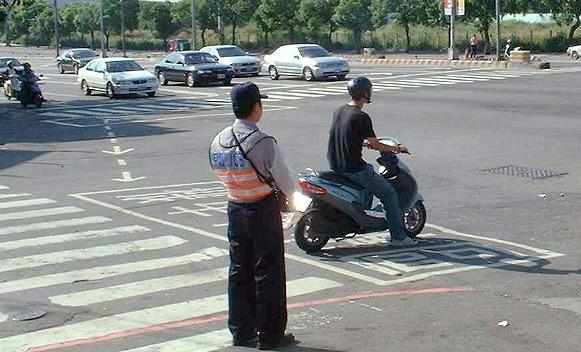
-
In Paris, France, traffic is allowed to turn across barrier-separated
bus/bicycle lanes, like the one in the photo below, at unsignalized intersections. The
checkerboard markings are intended to alert everyone to the resulting hazard. Unlike most
of the examples shown up to this point, this arrangement violates the fundamental
traffic-engineering principle of destination positioning before intersections.
|
Barrier-separated bike/bus lane, Paris, France
More Paris photos on Alan Forkosh's site
 Paul Schimek photo |
Other highly unusual bus lane/bike lane combinations which place
bicyclists into conflict with turning traffic are found in Minneapolis, Minnesota,
USA. The one shown below, on Hennepin Avenue, puts bicyclists into conflict with buses and
general traffic that turn across the bike lane, and then requires the bicyclists to merge
across three lanes of arterial traffic to continue lawfully on their way. Most bicyclists
choose instead to ride opposite the designated direction of traffic in the one-way bike
lane shown in the foreground of the photos.
|
Sequence of photos showing movements with two-way center
bike lane;
Hennepin Avenue at Washington Avenue, Minneapolis, Minnesota, USA
[More photos of
Hennepin Avenue bike lane, and discussion]
- Routing bicyclists on sidewalks where there are bus stops adds
another problem to the usual ones with sidepaths: bicyclists are placed in conflict with
the passengers who are being picked up and discharged.
|
September, 1992: Sidepath in Montréal, Québec, Canada goes
up onto the sidewalk to
make room for the bus stop. Although the installation had been in place for less than
two years, every second barrier post appears to have been removed, probably in
an attempt to reduce the risk of handlebar snagging. The curbs at the
lower right and left can sweep a bicycle out from under the bicyclist.
This installation looked much different in 2008 -- see photo.
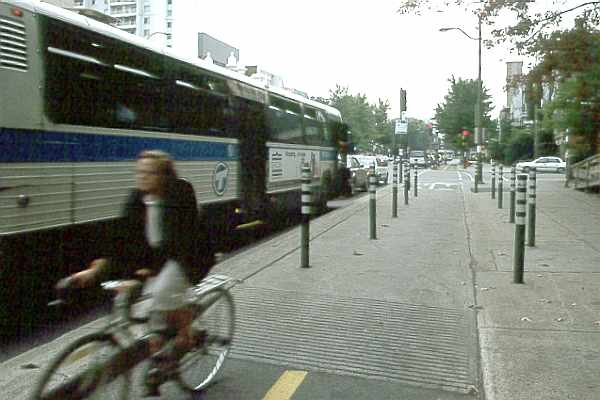
Summary
Several types of accommodations for bicyclists and buses have been shown. Some function
adequately, while others only increase the number and severity of conflicts and sightline
restrictions. The better installations allow both the bicyclists and bus drivers to
operate according to standard principles of traffic flow, without the need to yield to
other vehicles (bicycles, buses or other) approaching from behind in a different lane,
except by merging. |














